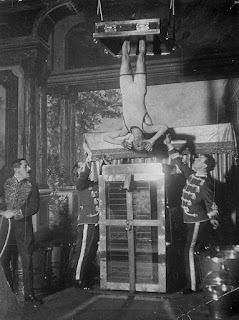In 1908, Harry Houdini introduced the "Milk Can Escape," a stunt that quickly became one of his signature acts.
In 1908, Harry Houdini introduced the "Milk Can Escape," a stunt that quickly became one of his signature acts. In this perilous performance, Houdini would be handcuffed and then sealed inside an oversized, water-filled milk can. The can was then locked inside a wooden chest, which was also filled with water, and padlocked.
The stocks were then locked to the top of the tank to prevent him from turning or lifting his head above water.
With the curtain hiding him from the spectators' eyes, Houdini would work to free himself before running out of breath, emerging triumphant moments later.
The element of mortal danger and Houdini's incredible skill made the Chinese Water Torture Cell a breathtaking spectacle that solidified his reputation as a master escape artist.
The act was so dramatic and emblematic of Houdini's daring that it continues to captivate the imagination, embodying the indomitable spirit of one of history's most iconic magicians
To raise the stakes, Houdini often invited audience members to hold their breath along with him, emphasizing just how long he'd have to hold his own breath to escape. He typically invited local craftsmen to construct the can and chest, adding an element of authenticity and reducing skepticism about potential trickery. Houdini would usually escape within a few minutes, although to the audience it felt like an eternity.
While the mechanics of the escape were kept a secret, the act itself became a symbol of Houdini's ability to defy seemingly impossible circumstances. Like many of his acts, the Milk Can Escape captivated audiences and contributed to Houdini's lasting legacy as one of the greatest escape artists in history.





Comments
Post a Comment